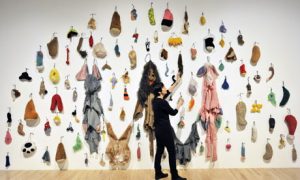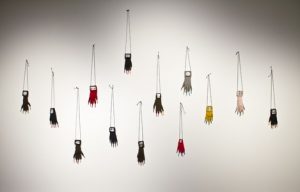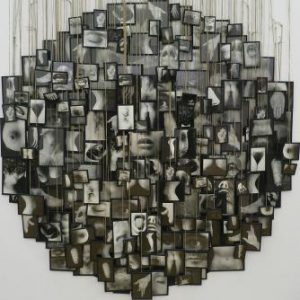– Star Wars Celebration starts tomorrow but we’re still here to deliver the quality content you desire. – Plus we’re workaholics. – That too. – This is The Star Wars Show. Hello, and welcome to The Star Wars Show. The only Star Wars show that really has to get to the airport because we may miss our flight to Celebration. – Yeah, let’s get to the news. – Star Wars Jedi Fallen Order was announced last year but up until now, not much has been known about the game other than the title and the fact that it takes place after the events of episode three. – Well that all changed yesterday when EA finally revealed both star wars canvas and the official logo of the game. – The star wars canvas art features the mysterious glowing hilt of a broken lightsaber and some sort of ancient scripture glowing underneath it. – What does it mean? – Hopefully we’ll get answers this Saturday April 13th at PM central time during EA’s Star Wars Jedi Fallen Order panel which, coincidentally, will be streamed by The Star Wars Show live.
– But it’s not just the Fallen Order panel we’re streaming. Oh no. – The fun starts on Friday at AM central with the episode nine panel, where director J.J. Abrams, and Lucasfilm president Kathleen Kennedy will take the stage, along with surprise guests, to talk about the final film in the Skywalker saga. – Later that afternoon at PM central ILMxLAB will hit the stage to talk about the new VR Series Vader Immortal. – Friday will also bring a look back at 20 years of LEGO Star Wars, a look at the creatures aliens and droids of Star Wars, plus tons of surprise guests and interviews right on our stage. – On Saturday morning at AM central we’re kicking things off with Galaxy’s Edge, where Walt Disney imagineers and members of the Lucasfilm story group hit the stage to talk about what it took to bring the Black Spire Outpost on the planet of Batuu to life inside Disneyland and Disney’s Hollywood Studios in Florida.
– Later that afternoon at will be playing the aforementioned Star Wars Jedi Fallen Order panel, plus a look back at Star Wars Rebels, as well as more reveals and interviews on our stage. – Then on Sunday, Jon Favreau and Dave Feloni will take the stage to talk about The Mandalorian, the brand new live action Star Wars series coming to Disney Plus in a panel you will not want to miss at AM central. – And if you thought Dave Feloni was stopping with one panel in a day you would be dead wrong because at PM central he’s taking the stage again with a sneak peak of the brand new season of The Clone Wars.
– Then on Monday, celebrate tax day the way it was intended with a celebration of the 20th anniversary of the most action-packed movie about trade disputes and political discourse, Star Wars episode one, the Phantom Menace. – Panel begins at AM central time and is followed at with an exclusive first look at the second season of Star Wars Resistance. – All those panels, plus tons of interviews on our stage, segments out on the floor of Celebration, and lots and lots of surprises are in store for The Star Wars Show live. – It all starts on Friday at AM on StarWars.com and cheapwallarts.com. So make sure you subscribe right now so you don’t miss a second. – And for more breaking news from around the galaxy, and trust us there’s going to be a whole lot of it coming out this weekend, check out Star Wars dot com slash SWS. – The Star Wars Show presents Everything is Important. This week, Star Wars Celebration. Originating on April 30 1999 in Denver, Colorado with the Wings Over the Rockies Air and Space Museum, Celebration was started as a way to celebrate the Star Wars franchise and the upcoming release of Star Wars Episode One: The Phantom Menace.
Expanding around the globe to places like London, Japan, Germany, Orlando, and this year in Chicago, Celebration brings fans together to show their love of Star Wars with many other fans, even cast-playing as their favorite characters. Fan organizations like the 501st Legion, Rebel Legion, Droid Builders, Saber Guild, and the Manda Mercs also joined in on the fun, making this event the place to be for Star Wars fans. Because of Celebration, fans are able to get the latest and greatest in Star Wars news direct from the creators themselves, meet their favorite celebrities, and hang out with other Star Wars fans from around the world. And without Star Wars Celebration, The Star Wars Show wouldn’t be able to capture some of the fun for viewers at home with memorable moments like John Boyega crashing a trailer breakdown, Hayden Christiensen sharing his thoughts about sand, it’s not very smooth, amazing sets built by the Belgian Props Crew, a couple getting married, and the world being introduced to Oki, the Star Wars vegetable-carving master.
Thanks, Star Wars Celebration. – We’re under attack. – I’ll take the guns. – Master Dooku. – Are you ready? – This audio original is the back story of Count Dooku. How he joined the Jedi Order, and then ultimately how he leaves the Jedi Order. – That’s insane. – Yes. – This is really different because it’s a massive cast of actors and different voices. – I thought you said we could eject here. – You’re imagining things. – Speak only when they have something useful to say. – We’ve had to create several new characters for this book. – Here we are doing this amazing sci-fi world being those characters together.
– Have you done this before? – No. – Audio books are so popular. We wanted to tell a narrative fiction story with light sabers, and music, and sound effects that you’re going to be listening to on your Star Wars adventure. – It’s very, very cool. – You’re watching SWC. Buy something, won’t ya? – Hello and welcome to SWC, the only Star Wars Celebration shopping channel on the internet. – Where we don’t make it unless you’ll buy it. And my stars, do we have a collection for you today.
– That’s right, Anthony. Did you know that there is a Star Wars show? – Ah, yes, The Mandalorian. – No, the other Star Wars show. The one that was nominated for multiple Emmys. – Ah, of course you’re talking about the Clone Wars. Very excited to catch up with Anakin and Snips again. – No, I wish. This Star Wars show is on the internet. – Wait, they give out Emmys for internet shows now? What’s next, People’s Choice Awards? – No, I’m talking about The Star Wars Show from the internet. – Yeah, I have never heard of it. – And this year at Star Wars Celebration they have their own merchandise. – Well you know how much I love merchandise with logos on it. – Would you like to see what they’re offering this year at the Star Wars Celebration store? – Would I? – Yeah, would you? – Yes.
– First, we have Kevin the Ewok showing off this stylish snapback hat featuring the mousetroid CH-33Z. And hats are perfect for those rainy days, or days you just want to hide a bald spot. – Oh, and look who just showed-up. It’s Gonk wearing a stylish long sleeve shirt in a throwback pattern that reminds me of Miami Beach in 1987. Oh look, it’s the star of Rogue One A Star Wars Story and Star Wars Rebels chopper, and it looks like he’s wearing a shirt for his side business he’s running now.
– I guess someone spent all their TV and movie money too fast and had to get a real job. – And now he’s being joined by partner CH-33Z who also has a short sleeve show logo shirt taped to his side. – And the shirt is the color black like the vastness of space where the hit film series Star Wars takes place. – It looks like Kevin the Ewok has returned and he’s holding up a shirt instead of wearing it.
– Yes, even though the shirt says Star Wars is for everyone, shirts aren’t for Ewoks. They hate clothes that aren’t wrapped around their heads. – Wow, this truly is a collection for the ages, and one that you’re going to want to make sure to collect every single piece of when it’s for sale at Star Wars Celebration in the Star Wars Celebration store in Chicago. – Ah, Chicago, the Big Apple. – The City That Never Sleeps. – The Big Easy. – The City of Angels. – You know what they say, what happens in Chicago stays in Chicago. – They knew. – Coming up next more stuff with Star Wars logos, so stay tuned for more SWC shopping right here on SWC. – Watching the Star Wars. – The show. – You know, I think we got through this show in record time. – Good, we needed to because we are still here and we literally need to go catch our flight.
– That we do, so no more fun host banter to pad out time. – Right, remember to like the video, subscribe to the channel, follow us on Twitter, Facebook, and Instagram. And watch the Star Wars Show live this week. It is going to be a blast. Our stage is unbelievable this year. – Massive. We do not deserve a stage this great. Also protip, remember to bring hand sanitizer with you.








